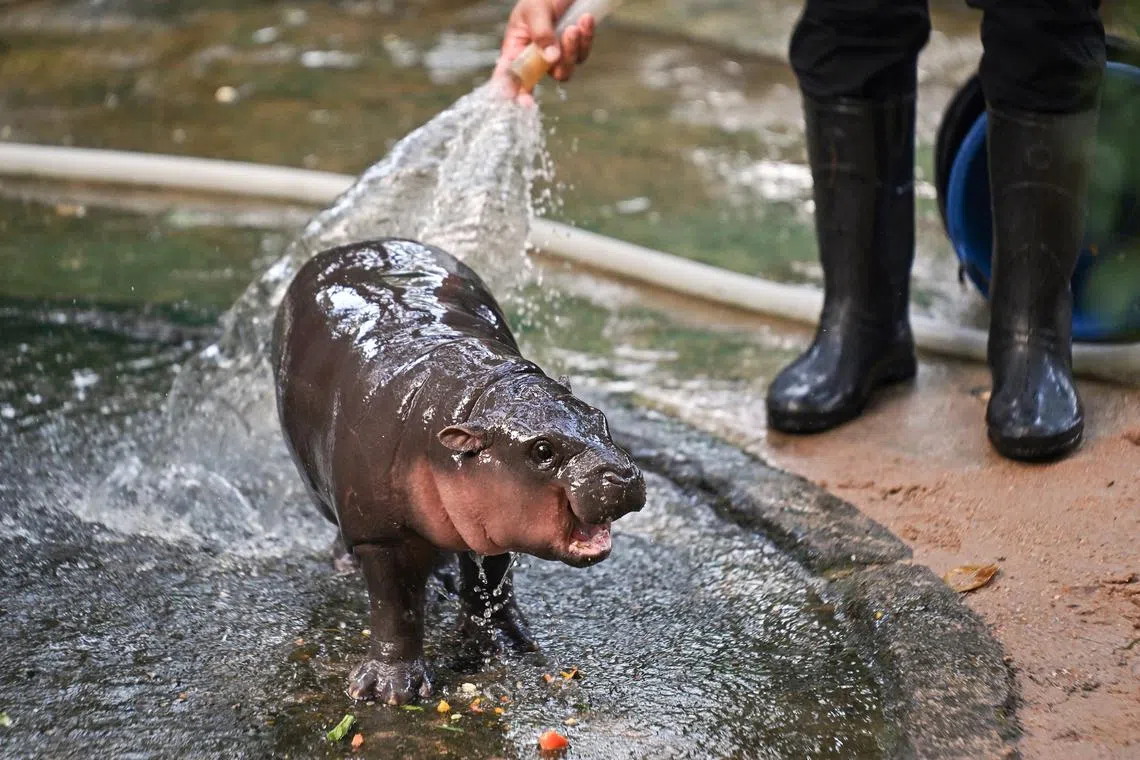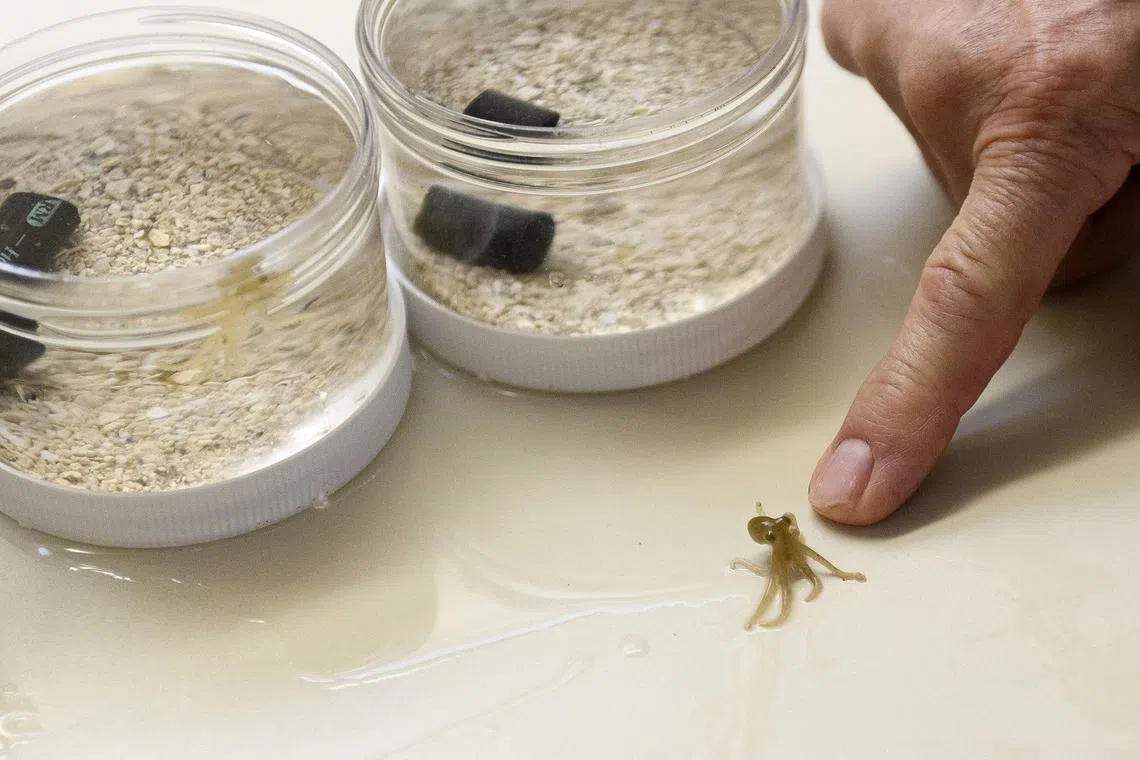The animal celebrities who surprised, soothed and screamed at us in 2024
Sign up now: Get ST's newsletters delivered to your inbox

Moo Deng, a female pygmy hippo living in a Thailand zoo, has been routinely compared to a potato.
PHOTO: AFP
Follow topic:
NEW YORK – Every year has its breakout stars, and 2024 yielded a bumper crop: actor Glen Powell, singer Chappell Roan and the Pommel Horse Guy (also known as gymnast Stephen Nedoroscik).
But only one had a body that was routinely compared to a potato. She was slippery; she was feisty; she was named after a type of pork meatball.
She was, of course, Moo Deng, the pygmy hippo that rocketed to fame
She was not the only non-human newsmaker this year. Indeed, 2024 was the year that animals seemed to do it all, becoming A-list celebrities, political weapons and cautionary tales. Along the way, they often served as welcome distractions from the messy human world – but also clear reflections of it.
Here is a look at the creatures that broke the internet (and sometimes our hearts) in 2024.
The social media sensations
It is a tale as old as time: Baby zoo animal is born; baby zoo animal is posted online; baby zoo animal goes viral.
This year, an enormous king penguin chick named Pesto – a 23kg tower of downy brown fluff
But Moo Deng, who was born at Khao Kheow Open Zoo in Thailand, seemed to tap into something deeper. Sure, she was adorable. But when she was not sleeping (which was often), she seemed perpetually peeved, throwing tantrums, biting her keepers and appearing to scream silently.
Online, she was hailed as “ungovernable” and even portrayed as an aspirational figure for women – with her unapologetic attitude and enviably dewy skin.
As a feminist icon, however, Moo Deng was an uncomfortable choice. She was a member of an endangered species – just a few thousand pygmy hippos remain in the wild – and lived in a zoo, where visitors had taken to throwing objects at her.
Her name, which literally meant “bouncy pork”, referred to a type of meat, and her image was co-opted to sell everything from make-up to cryptocurrency.
While social media stardom can be harnessed to support conservation efforts, it can also have the opposite effect.
“Whenever there’s a very notable celebrity animal, especially a wild animal, there’s an uptick in desire to own them,” said Dr Siobhan Speiran, an animal welfare scholar and geographer at York University in Canada. That was the sentiment that Moo Deng tended to elicit from online commenters: “It tends to be, ‘Oh, I want her.’”
The marine marvels
Moo Deng may have been a handful, but at least there was just one of her. In Oklahoma, the Clifford family discovered that its new pet octopus, Terrance, had not only been misidentified as a male but had also laid 50 fertilised eggs. The family attracted a large online audience as it chronicled its herculean efforts to keep the fragile hatchlings alive.

A baby hatchling of pet octopus Terrance, which had been misidentified as a male, exploring outside its jar.
PHOTO: NYTIMES
Still, when it came to surprises, Terrance had nothing on Charlotte, a stingray that appeared to have become pregnant despite the absence of male rays in her tank at the Aquarium & Shark Lab in North Carolina.
The aquarium floated two possible explanations. The first was parthenogenesis, a well-documented phenomenon in which the eggs of some species can develop into viable embryos without being fertilised by sperm. The second was that Charlotte had mated with one of the male sharks that shared her tank and was now pregnant with “a whole new species”.
The shark-mating theory was “obviously, preposterously silly”, marine conservation biologist David Shiffman said. “Sharks and rays are separated by as many years of evolution as humans and snakes. If a human tried to mate with a snake, it would not result in a human-snake hybrid.”
But the idea set off a media frenzy. After months had passed with no signs of stingray pups, the aquarium announced that Charlotte had “developed a rare reproductive disease”, then that she was “no longer pregnant” and then that she had died.
In an e-mail, Ms Brenda Ramer, who runs the aquarium, said that a post-mortem examination had confirmed the reproductive disease, but she did not provide additional details or answer questions about whether Charlotte had ever actually been pregnant. (Some experts have speculated that Charlotte may have had a disease that mimicked the signs of pregnancy.)
The political animals
Not since US Senator Mitt Romney came under fire for transporting his dog in a kennel on the roof of his car have pets earned so much media coverage during a presidential race.
Governor Kristi Noem of South Dakota saw her vice-presidential prospects dim when she boasted about shooting and killing her misbehaving young dog.
Vice-President-elect J.D. Vance was assailed for dismissing Democrats as “childless cat ladies”.
In a nationally televised debate, President-elect Donald Trump repeated false claims that immigrants were stealing and eating pets P’Nut, which had been euthanised
If there was a coherent political message here, it was difficult to discern. But one through line was that the United States is, by and large, a nation that loves its pets.
Even for Trump – a rare pet-less president – Ms Noem’s story seemed to cross “this invisible boundary”, said Professor Clive Wynne, a canine-behaviour expert at Arizona State University.
And then there was Robert F. Kennedy Jr, who confessed to depositing a dead bear cub in New York City’s Central Park and who was said to have used a chain saw to decapitate a dead whale. (He then supposedly strapped the whale head to the top of his car and drove it home in a gruesome, cetacean version of the Romney affair.)
The lessons of these stories remain elusive. “What historical or cultural trend can we connect it to?” Prof Wynne asked. “Just the vastly privileged doing vastly stupid things.”
The borderline wild
In a world transformed by humans, the line between captive animals and wild ones can be as fuzzy as the creatures that occupy that awkward middle ground. Take Nibi, a beaver that was found alone in the wild when she was far too young to fend for herself.
At Newhouse Wildlife Rescue, in Massachusetts, Nibi developed a taste for pistachios, a fondness for humans and an apparent contempt for others of her own kind. (In one video, she appears to be building a dam in the doorway of the rescue’s rehab room to keep another young beaver at bay.)
Newhouse eventually deemed her both a “diva” and “unreleasable”, so ill-suited for life in the wild that it went to court when a state agency ordered her release. The state governor ultimately intervened, allowing Nibi to remain at the facility.

Celebrity eagle-owl Flaco, which escaped from the Central Park Zoo, died in February.
PHOTO: NYTIMES
In New York City, the life of a Eurasian eagle-owl named Flaco took the opposite trajectory when he escaped from the Central Park Zoo. Flaco had lived his entire life in captivity, but he proved to be an adept predator, doing his part to keep the city’s rat population in check.
In February, after a year on the lam, Flaco died. The immediate cause appeared to be that he had hit a building, but a necropsy revealed that Flaco also had dangerously high levels of toxic rodenticides in his system.
These compounds, which are widely used for rat control, pose a well-known threat to birds of prey. NYTIMES

